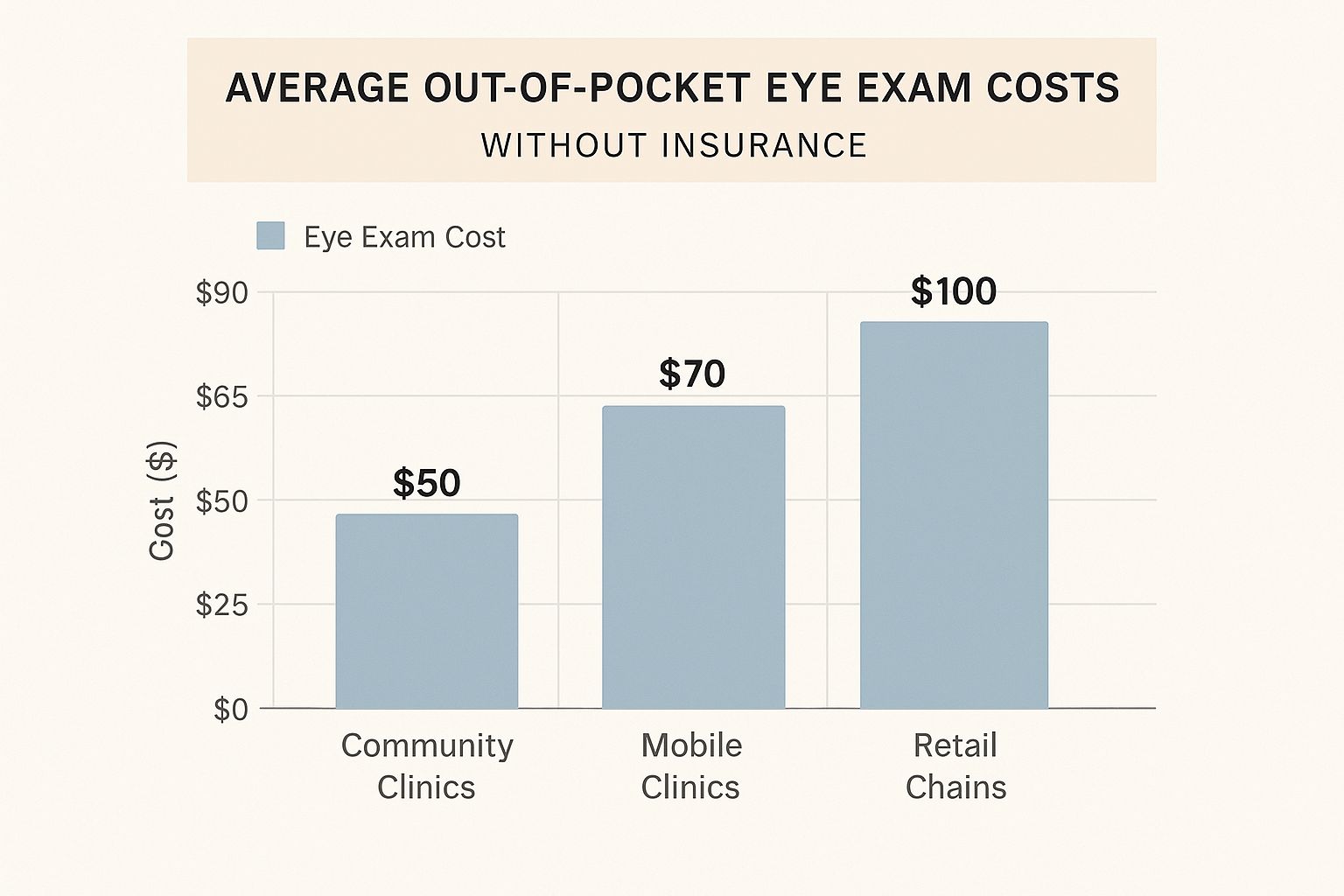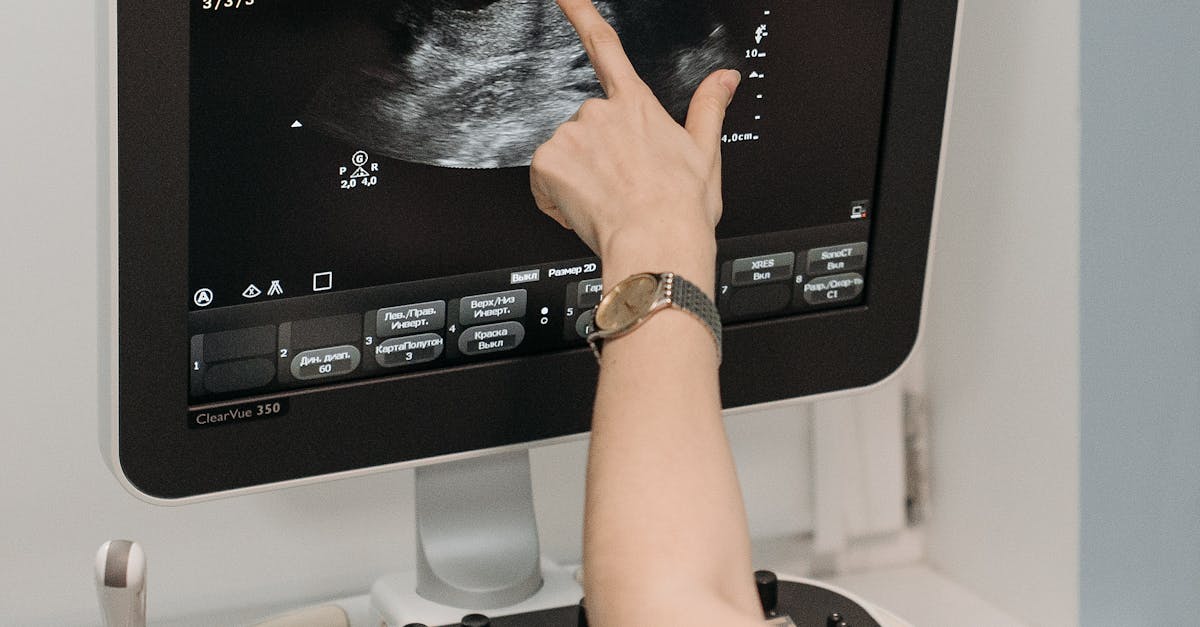So, you’re in Glendale Heights and need an eye exam but don’t have vision insurance. Don’t worry, you’ve got some solid options. It really comes down to knowing the landscape—the differences between community clinics, big retail chains, and a private practice like ours at iDoctor.
While some routes might seem cheaper upfront, paying directly for our detailed, 30-minute exam at our boutique practice offers clear, honest pricing and the kind of advanced diagnostic tech that is a real investment in your future health. For residents of Glendale Heights, investing in your eye health locally is a smart choice.
Navigating Your Eye Care Options in the Glendale Heights and Schaumburg areas
Finding the right place for an eye exam without insurance can feel like a chore, but it doesn’t have to be. Your eyesight is just too important to neglect, and cost shouldn’t stand in the way of getting great care. If you live in or around Glendale Heights, you have a few different paths to consider, each with its own pros and cons.
A lot of people automatically think of the big retail stores or community health centers. They’re often seen as the go-to for saving money, and for a simple vision screening, they can be a decent choice. The trick is to know exactly what you’re paying for.
- Community Health Clinics: These often work on a sliding scale based on your income, making them a very affordable choice for a basic check-up.
- Retail Optical Chains: You can’t beat the convenience. They have walk-in appointments and are always running some kind of deal on exams and glasses.
- Private Optometry Practices: This is where you’ll find truly in-depth, personalized care. At iDoctor, we’re talking advanced technology that goes way beyond just figuring out your new prescription.
This chart gives you a good visual of the typical cost differences you’ll run into when paying for an eye exam out-of-pocket.
As you can see, there’s a definite trade-off. You’ll generally pay less at a community clinic, but the scope of the exam might be more limited compared to what you’d get at a retail chain or private office.
The Hidden Value in Paying Directly
While clinics and retail stores certainly have their place, choosing to invest in a comprehensive exam at a private practice like iDoctor offers a completely different kind of value. For many of our patients from nearby towns like Schaumburg, paying out-of-pocket means getting care that’s focused on their long-term health, not just a quick fix for blurry vision.
To help you weigh your choices, here’s a breakdown of what to expect from each option.
Comparing Your Options for Uninsured Eye Exams
This table breaks down the typical features, costs, and benefits of different avenues for getting an eye exam when paying out-of-pocket, helping you choose the best fit for your needs and budget.
| Option | Typical Cost Range | What’s Included | Best For |
|---|---|---|---|
| Community Health Clinic | $50 – $100 | Basic vision screening, prescription check. May have income requirements. | Those on a very tight budget needing a basic prescription update. |
| Retail Optical Chain | $80 – $150 | Standard eye exam, prescription, often bundled with glasses/contact lens deals. | Convenience, walk-in availability, and one-stop shopping for glasses. |
| Private Practice (like iDoctor) | $99 | Comprehensive exam, high-resolution retinal imaging (an additional $39), eye health diagnostics, personalized consultation. | A proactive approach to eye health, detecting early signs of disease, and personalized care. |
Ultimately, the best choice depends on what you’re looking for—a quick, affordable prescription or a deep dive into your overall eye health.
Key Takeaway: At iDoctor, our self-pay patients get the exact same detailed eye exams in Glendale Heights as our insured patients, complete with high-resolution imaging. There are no shortcuts.
This thorough approach is what allows us to spot the early warning signs of serious health issues, like glaucoma, diabetic retinopathy, or even high blood pressure. Catching these problems early can save you from much bigger health complications—and costs—down the line. It really changes the exam from being just another expense into a smart, proactive investment in your well-being. Knowing all this, you can make a decision that feels right for both your health and your wallet.
What You’re Really Risking When You Skip an Eye Exam
It’s tempting to look at the cost of an eye exam without insurance and think, “I’ll just wait.” After all, if your vision seems fine, why spend the money? I’ve heard this from countless people over the years, and while I understand the logic, it misses the bigger picture. A comprehensive eye exam is about so much more than just a new glasses prescription.
The true cost of putting off that appointment isn’t what you save today. It’s the potential for serious health problems—and much higher bills—down the road. Many of the most damaging eye conditions, like glaucoma, diabetic retinopathy, and macular degeneration, creep in silently. They often have no noticeable symptoms in their early stages, which is precisely when we can treat them most effectively.
This is a bigger problem than you might think. Research shows that about 50% of U.S. adults skip their annual eye exams, often because of cost or because they don’t feel like anything is wrong. What’s truly concerning is that only 37% of people know that vision loss can happen without any warning signs. That knowledge gap can be dangerous. For more on these eye health awareness stats, you can see the full findings on visioncenter.org.
The Long-Term Price of “Waiting It Out”
By the time you actually notice a persistent issue, like blurry vision, the underlying condition has likely had a significant head start. At that point, treatment becomes more invasive, more expensive, and often, less successful.
Think about it this way:
- Glaucoma: If we catch it early, we can often manage it with simple, inexpensive eye drops. But if it goes undetected, it can cause permanent vision loss and may require costly surgery.
- Diabetic Retinopathy: This is a top cause of blindness in working-age adults. Regular exams let us see changes in the tiny blood vessels of your retina long before you’d notice a change in your sight, allowing for timely care that can save your vision.
- Cataracts: They’re common, but tracking their progression lets you schedule surgery when it makes sense for your life—not when it becomes an emergency that severely affects your ability to function.
This proactive approach is why so many families in Carol Stream and the surrounding communities put their trust in iDoctor. They see our detailed exams not as a cost, but as a critical investment in their long-term health. It’s about the peace of mind that comes from knowing an expert is looking out for them.
Don’t Brush Off the Small Stuff
Sometimes, the signals are quiet—a few more headaches than usual, a little trouble driving at night, or text that occasionally seems fuzzy. It’s incredibly easy to write these off as just being tired or stressed.
But these subtle changes can be your eyes trying to tell you something. If you’ve been noticing any shifts, no matter how minor, it’s worth understanding what causes blurry vision and having a professional take a look.
An out-of-pocket exam today is a small price to pay to avoid a future of major medical bills for advanced treatments. More than that, it’s about protecting your sight. Investing in your eye health now is one of the smartest things you can do for your future.
Tapping into Public and Community Health Options
When you’re trying to find an eye exam without insurance and are on a tight budget, your first thought might be to check out public health resources. It’s a logical starting point. Places like Federally Qualified Health Centers (FQHCs) or local non-profits are set up specifically to offer essential services at a lower cost, often on a sliding scale based on your income. They are a true lifeline for many in our communities, including folks from nearby Lombard.
However, from my experience, it’s really important to go in with your eyes wide open about what these options can realistically provide. While they are certainly budget-friendly, there are often significant trade-offs to consider.
What to Realistically Expect
When you opt for these low-cost routes, what you’re typically getting is a basic vision screening, not the kind of deep-dive, comprehensive exam that can catch serious eye diseases before they become a problem.
Here’s what you might run into:
- Long Wait Times: These centers are in high demand. It’s not uncommon to wait weeks, sometimes even months, for an appointment to open up.
- Limited Scope: The main goal is usually just to figure out your prescription. Getting eyeglasses or contact lenses covered is a different story and often isn’t part of the deal.
- Basic Equipment: They may not have the advanced, high-resolution imaging technology we use to spot the earliest, most subtle signs of conditions like glaucoma or macular degeneration.
This last point is crucial. When it comes to your health, what you can’t see is often what matters most. To get a feel for the difference, you can learn more about what happens during an eye exam in a fully equipped private practice.
Understanding Gaps in Programs Like Medicaid
Even with government programs like Medicaid, you’d be surprised by the gaps in adult vision care. A 2023 study from the National Institutes of Health brought some of these issues to light. It found that a staggering 12% of Medicaid enrollees, which is about 6.5 million adults, have no coverage at all for routine eye exams.
It gets even tougher when it comes to eyewear. The study revealed that 27% of adults—that’s 14.6 million people—don’t have coverage for glasses through their Medicaid plan. These coverage rules aren’t the same everywhere, which makes navigating the system incredibly confusing for people who just need to see clearly. You can read the research on adult Medicaid vision coverage to see the full breakdown.
A Patient’s Perspective from Lombard: “I tried a community clinic first because of the cost, but the wait was incredibly long, and they couldn’t tell me anything about my eye health, just my prescription. It felt like I only got half the story.”
Public resources are absolutely valuable, and they serve an important purpose. But think of them as a starting point. Many of our patients find that making a small investment in a comprehensive exam at iDoctor gives them far more value and, more importantly, true peace of mind that their total eye health is being looked after.
Getting Real Value from a Private Practice
Paying for an eye exam out-of-pocket might feel like a splurge, but it’s often one of the best moves you can make for your health. Sure, community clinics and big retail chains offer the basics. But choosing a private practice like iDoctor unlocks a totally different kind of value. You’re shifting the focus from simply getting a new prescription to taking a deep, proactive look at your long-term eye health.
When you pay for an eye exam without insurance here, you get a dedicated 30-minute appointment. This isn’t some rushed, in-and-out screening. It’s a comprehensive evaluation where we use advanced, high-resolution imaging to see exactly what’s happening at the back of your eye. That level of detail is crucial for spotting the earliest, most subtle signs of conditions like glaucoma, macular degeneration, and even issues tied to high blood pressure.
Investing in Prevention for Future Savings
Think of it as preventive maintenance for your most precious sense. Honestly, catching a problem early doesn’t just protect your vision—it can save you a fortune in future medical bills. The cost of managing an advanced eye disease with specialized treatments or surgery down the road is exponentially higher than the price of one thorough exam today.
This is exactly why so many of our patients from Addison see the incredible value in what we do. They get it. They know our detailed approach gives them a complete picture of their vision health, putting them back in control and offering priceless peace of mind.
“I decided to pay out-of-pocket at iDoctor after a friend from Addison recommended them. The difference was night and day. They found early signs of pressure changes I had no idea about. I’m so grateful for that detailed exam; it felt like a true health investment.”
Transparent Pricing and All-in-One Convenience
At iDoctor, we’re all about being upfront and honest with our pricing, especially for our self-pay patients. You’ll know exactly what you’re paying for and the immense value packed into that cost. Our team will happily walk you through everything included in our comprehensive exam and advanced imaging. That clarity is a core part of our commitment to you.
We’ve also put together some fantastic packages that bundle our detailed exams with eyewear, making it much easier to get the styles you love. These bundles make our curated collection—from luxury brands like Cartier and Tom Ford to timeless classics like Ray-Ban—more accessible than ever. It’s the perfect way to combine world-class health care with high-end fashion, all in one friendly and convenient visit.
And if you’re curious about the specifics, we can explain how an eye pressure test works and why it’s such a non-negotiable part of a complete eye health assessment.
How to Prepare for Your Self-Pay Eye Exam
Walking into an eye exam, especially when you’re paying out-of-pocket, can feel a little daunting. But I’ve found that a bit of prep work can make all the difference. It helps you get the most value out of your appointment and gives you the confidence to talk through any concerns you might have. This is something we see time and again with our patients from Glen Ellyn who trust iDoctor for our in-depth approach.
When you’re prepared, we can spend our 30-minute detailed eye exam focusing on what truly matters: your specific vision needs and overall eye health.
Your Pre-Appointment Checklist
Having the right information ready when you walk in helps my team and me build a complete, accurate picture of your eye health history. Before you head over for your appointment, try to gather these key details:
-
A List of Current Medications: Don’t forget anything you take regularly. That includes over-the-counter stuff like allergy pills, daily aspirin, or supplements. Many common medications can have surprising side effects that impact your vision and eye pressure.
-
Your Family’s Eye Health History: Does glaucoma, macular degeneration, or even high blood pressure run in your family? Knowing your genetic predispositions gives us a heads-up on what to watch for, allowing for truly proactive care.
-
Specific Vision Concerns: This is a big one. Take a few minutes to jot down anything you’ve noticed, no matter how small it seems. Are you getting more headaches? Is night driving a little trickier than it used to be? Do your eyes feel strained after a few hours on the computer? Those little details are often the most important clues.
Expert Tip: Think of your eye exam as a collaborative health consultation, not just a simple check-up. Coming in prepared empowers you to be an active partner in your own eye care, ensuring all your questions get answered.
Making the Most of Your Visit
When you call to schedule, don’t be shy about asking about our self-pay pricing for an eye exam without insurance. Our team is always happy to walk you through our transparent costs and any package deals we have that bundle an exam with our great eyewear—from affordable frames by Michael Kors to luxury options from Gucci.
During the exam itself, I encourage you to ask about the high-resolution images we take of your eyes. These detailed pictures tell us so much, and I believe you should understand what we’re seeing and what it means for your health.
After we’ve finished, we’ll sit down and go over your prescription and help you find the perfect eyewear that fits your look, your life, and your budget.
For an even more detailed breakdown, be sure to check out our complete guide on how to prepare for your self-pay eye exam. A little planning helps us ensure every patient, especially our neighbors from Glen Ellyn, has a seamless and valuable experience at iDoctor.
Your Next Steps for Clear Vision in Glendale Heights
Trying to figure out vision care when you need an eye exam without insurance can feel a bit overwhelming. But I’m here to tell you that a lack of a vision plan shouldn’t ever stand in the way of your eye health, especially with the great options available right here in Glendale Heights.
You’ve got choices, from community resources all the way to the personalized, advanced care we offer at iDoctor. We’ve built our high-end optometry boutique on the principle that every single patient deserves the same detailed attention and clinical expertise, whether they have insurance or not.
Your Trusted Local Choice
We’re genuinely committed to being the go-to eye health partner for families in Glendale Heights and our neighbors in towns like Villa Park. It’s about more than just a quick exam; it’s about building a relationship focused on preventive care and giving you access to a world-class selection of eyewear. We truly believe everyone deserves to see their best.
“I didn’t have vision insurance but knew I needed a thorough exam. The team at iDoctor was so transparent about the cost and explained everything. It felt like a true investment in my health. Families in Villa Park are lucky to have this quality of care nearby.”
We would be honored to be your trusted local choice for both your long-term eye health and finding that perfect pair of glasses. Ready to take the next step? Give our Glendale Heights office a call. We’re happy to walk you through our straightforward self-pay pricing and discuss how we can help you get the crystal-clear, healthy vision you deserve.
FAQs About Self-Pay Eye Exams in Glendale Heights
It’s completely normal to have questions when you’re trying to manage healthcare costs without a vision plan. We get it. Here in the Glendale Heights area, our goal is to give you straightforward answers so you can feel confident taking care of your eyes.
What’s the cost of an eye exam without insurance at iDoctor?
We pride ourselves on transparent pricing, especially for our self-pay patients. The cost for an eye exam without insurance is a direct reflection of the comprehensive care you receive, including our detailed 30-minute appointments and the advanced imaging we use to get a complete picture of your eye health. We charge $99 for our comprehensive eye exam and an additional $39 for our retinal imaging. Since everyone’s vision needs are a little different, the best way to get an exact price is to give our Glendale Heights office a call. Our team is always happy to explain the costs and tell you about any package deals we’re running for exams and glasses that could save you money.
Can I pay for my exam and glasses with an FSA or HSA?
Absolutely. Using your Flexible Spending Account (FSA) or Health Savings Account (HSA) is a smart way to handle out-of-pocket vision costs. These pre-tax funds are perfect for covering your comprehensive eye exam, new prescription glasses, contact lens fittings and supplies, and even prescription sunglasses. We’ll make sure you get a detailed, itemized receipt to make submitting for reimbursement a breeze.
I’m in Bloomingdale. Why is iDoctor the best choice for me?
We’re incredibly grateful that so many of our patients make the short trip from Bloomingdale because they know they’re getting exceptional value and care. It’s more than just a simple vision screening; our advanced imaging provides a deep dive into your overall eye health. This really underscores the importance of routine eye exams as a crucial part of your wellness routine. Plus, with our carefully selected collection of both designer frames like Gucci and Prada and affordable eyewear from brands like Ray-Ban and Coach, you can take care of your exam and get the perfect new glasses all in one friendly, convenient visit.








